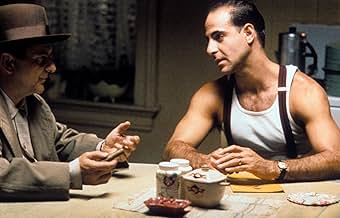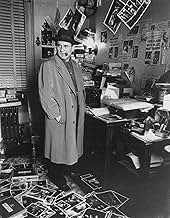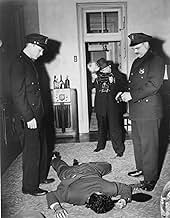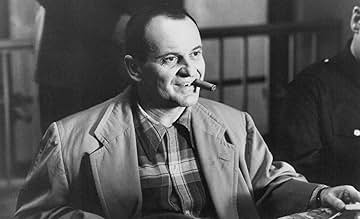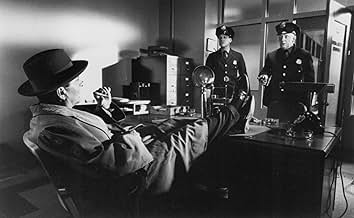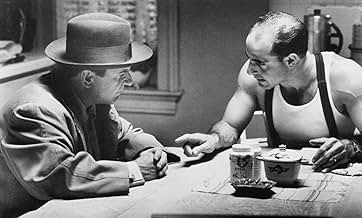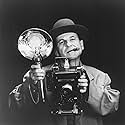NOTE IMDb
6,5/10
4,7 k
MA NOTE
Année 1942. Leon Berstein, le photographe le plus roublard de New York, est contacté par la belle Kay Levitz qui lui demande de réunir un dossier compromettant sur le gangster Spoleto.Année 1942. Leon Berstein, le photographe le plus roublard de New York, est contacté par la belle Kay Levitz qui lui demande de réunir un dossier compromettant sur le gangster Spoleto.Année 1942. Leon Berstein, le photographe le plus roublard de New York, est contacté par la belle Kay Levitz qui lui demande de réunir un dossier compromettant sur le gangster Spoleto.
- Réalisation
- Scénario
- Casting principal
- Récompenses
- 1 nomination au total
Christian Stolte
- Ambulance Attendant
- (as Christian Stolti)
Gian-Carlo Scandiuzzi
- Maitre D' - Cafe Society
- (as Gian-Carlo Scanduzzi)
Avis à la une
I appreciate that this film was more than a homage to film noir but actually advanced the genre to include populist themes and even women's issues. In many ways, this is film brun because so much effort is made to evoke the brown tones of the time which brought a warmer, less paranoid tone to the proceedings. Brown can be earthy or rich. Men wear brown suits and hats and chew on brown cigars. The nightclub is paneled in rich brown wood. Kay Levitz has brown hair. The script and direction showed a love for the time but a cynicism, too, of government collusion with organized crime to make money at the expense of the fighting men and the citizens during a time of war. I enjoyed the relationships between the characters and was touched by the pan of the cheering crowd of real people at the end, not usually seen in noir. To add to the comments about the actors: I also enjoyed Jerry Adler as Bernzini's friend and was intrigued by Jared Harris's Danny the Doorman.
This is a wonderful piece of work. The visual look of the movie is simply fantastic. But it should had been better if it was in black and white! In this case, Public Eye could be seen as a 1930's gangster movie. But the color of this movie looks like black and white. This film had anything I love about the Bogart, Robinson and Cagney movies. It's also give a chance to Joe Pesci to plays perhaps the role of his life. He's fabulous! Hard cigar smoking little guy ain't afraid of anything to have a good photography. He thinks big cities photos is art. He's also very moving, in the way Ernest Borgnine was in Marty, when he falls in love with wonderful Barbara Hershey. This is a great movie, one of the best American movie of the 1990's.
I've never rated this movie that high but I've gone back to it three times since it came out about 15 years ago on tape, so maybe I am underrating this. There still is no DVD of it, at least in Region I, and that's frustrating. There's something intriguing about this story that drives me back to it.
Perhaps that is so because it's about a photographer, something I did, too, while being in the newspaper business for years and an art form I've always enjoyed. The story also takes place in the 1940s and I love the style and atmosphere of that era which is beautifully shown here.
Joe Pesci is Leon Bernzini or "The Great Bernzini," a newspaper photographer and Barbara Hershey is a mysterious woman who Pesci has the hots for. There is a lot of mystery in here with Hershey's character. Pesci takes gruesome photos, doesn't get involved with anyone but he's willing to make an exception with "Kay Levitz" (Hershey)..... but is she good or bad for him?
Sad to say, the filmmakers kind of make a hero out of basically a sleazy guy who has few, if any, morals. ("Bernzy" was "paparazzi" before they invented the word!). The movie also has an unsatisfying ending, particularly with Hershey's character.
However, I keep getting drawn back into multiple viewings of this and I'd sure like to see what it looks like with a good DVD transfer.
Perhaps that is so because it's about a photographer, something I did, too, while being in the newspaper business for years and an art form I've always enjoyed. The story also takes place in the 1940s and I love the style and atmosphere of that era which is beautifully shown here.
Joe Pesci is Leon Bernzini or "The Great Bernzini," a newspaper photographer and Barbara Hershey is a mysterious woman who Pesci has the hots for. There is a lot of mystery in here with Hershey's character. Pesci takes gruesome photos, doesn't get involved with anyone but he's willing to make an exception with "Kay Levitz" (Hershey)..... but is she good or bad for him?
Sad to say, the filmmakers kind of make a hero out of basically a sleazy guy who has few, if any, morals. ("Bernzy" was "paparazzi" before they invented the word!). The movie also has an unsatisfying ending, particularly with Hershey's character.
However, I keep getting drawn back into multiple viewings of this and I'd sure like to see what it looks like with a good DVD transfer.
I was stunned by this movie when I saw it, because I'd never heard of it before and it was so excellent. Joe Pesci puts in possibly the best performance of his career, far different than many of his other roles (in other words, he doesn't play a little angry, cursing mobster). Another great actor, Barbara Hershey, also puts in a great performance. The film is directed with subtle but powerful artistry. There are actually themes in this movie! Metaphors! Basically, it's just plain great, but of course totally overlooked because it's not your typical overdone Hollywood film. My favorite scenes are these: the part in the middle of the gun battle when Pesci's character gets a gun pointed at his head, but can only respond by lifting up his camera and taking a picture, and the very final scene when Pesci's buddy tries to turn off his police scanner and he says, "You can't turn it off." A great film.
Movies should be able to transport you to the time and place without much effort. "The Public Eye" does so. I saw this in -- of all places -- a redeye bus trip from New York to DC, and this only enhanced the viewing enjoyment. This is definitely a movie to "get into the mood" for 40's noir, down to the gritty life of the City After Dark.
This one keeps getting overlooked as one of the best of the 90's. See this one.
This one keeps getting overlooked as one of the best of the 90's. See this one.
Le saviez-vous
- AnecdotesIt took Howard Franklin 10 years before he could get his screenplay turned into a film.
- GaffesWhen Kay leafs through Bernstein' photo album, there is picture of a New York City taxi with a rectangular roof light which displays not only the word "Taxi" but also whether the taxi is off duty and its medallion number. Those signs did not come into service until the 1960s. In the 1940s, when the movie is set, New York City taxis used a variety of curved roof lights used in most other cities.
- Citations
Kay Levitz: It doesn't matter what people say unless you believe them.
- Bandes originalesYou Can't Say No to a Soldier
(1942)
Music by Harry Warren
Lyrics by Mack Gordon
Performed by Sammy Kaye and His Orchestra
Courtesy of Sandy Hook Records
Meilleurs choix
Connectez-vous pour évaluer et suivre la liste de favoris afin de recevoir des recommandations personnalisées
- How long is The Public Eye?Alimenté par Alexa
Détails
Box-office
- Budget
- 15 000 000 $US (estimé)
- Montant brut aux États-Unis et au Canada
- 3 067 917 $US
- Week-end de sortie aux États-Unis et au Canada
- 1 139 825 $US
- 18 oct. 1992
- Montant brut mondial
- 3 067 917 $US
- Durée1 heure 39 minutes
- Couleur
- Rapport de forme
- 1.85 : 1
Contribuer à cette page
Suggérer une modification ou ajouter du contenu manquant


